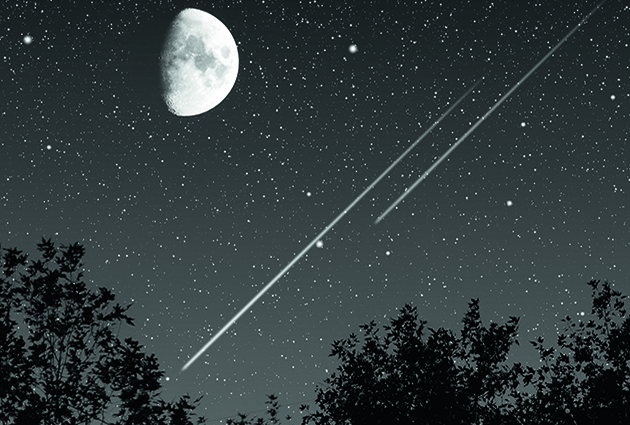Star gazing dates for the year ahead
Get into stargazing with our handy guide to the top dates to see wonderful things in the night sky this year


Not many things remain as out of reach as our starry skies, but the magic of the universe continues to capture our imagination. Ink these dates for 2016 into your diary and take time to look up and wonder–it’s good for the soul
The best times to see meteors 2016 The Quadrantids January 1–10 (maximum January 3–4) These brilliant, bluish and yellowishwhite meteors may, at maximum, even reach a rate of 120 meteors per hour. The shower is named after the former constellation Quadrans Muralis Lyrids April 22–23 Eta Aquarids May 6–7 Alpha Capricornids July 27–28 Perseids August 12–13 Delta Aqurids July 28–29 Alpha Aurigids August 28 and September 15 Southern Taurids October 23–24 Northern Taurids November 11–12 Orionids October 21–22 Leonids November 17–18 Geminids December 13–14 Ursids December 21–22
Star gazing dates for the year ahead
January New Moon January 10, 1.31am Full Moon January 24, 1.46am
The Earth reaches perihelion (the closest point to the Sun in its annual orbit) on January 2 at 10.49pm Universal Time. Its distance is then 147,100,175km (91,403,811 miles).
Looking north Ursa Major stands more or less vertically above the horizon in the north-east, with the zodiacal constellation of Leo rising in the east. To the north, the stars of Ursa Minor lie below Polaris (the Pole Star). Looking south At this time of the year, the southern sky is dominated by Orion. This is the most prominent constellation during the winter months. It has a highly distinctive shape, with a line of three stars that form the famous ‘Belt’.
February New Moon February 8, 2.39pm Full Moon February 22, 6.20pm
Sign up for the Country Life Newsletter
Exquisite houses, the beauty of Nature, and how to get the most from your life, straight to your inbox.
Looking north January and February are probably the best months for seeing the section of the Milky Way that runs in the northern and western sky from Cygnus, low on the northern horizon, through Cassiopeia, Perseus and Auriga and then down through Gemini and Orion. Looking south Apart from Orion, the most prominent constellation visible this month is Gemini, with its two lines of stars running south-west towards Orion. Using Orion’s Belt as a guide, it points down to the south-east towards Sirius, the brightest star in the sky.
March New Moon March 9, 1.54am Full Moon March 23, 12.01pm
Looking north The Sun crosses the celestial equator on Sunday, March 20, at the vernal equinox, when day and night are of almost exactly equal length, and the season of spring is considered to have begun. Summer Time begins in Europe on Sunday, March 27 Looking south Prominent in March is the constellation of Leo, with the ‘backward question mark’ (or ‘sickle’) of bright stars forming the head of the mythological lion.
April New Moon April 7, 11.24am Full Moon April 22, 5.24am
Looking north Cygnus and the brighter regions of the Milky Way are now becoming visible, rising in the north-east, with the small constellation of Lyra and the distinctive ‘keystone’ of Hercules above them. Looking south Leo is the most prominent constellation in the southern sky in April and vaguely looks like the creature after which it is named. Gemini, with Castor and Pollux, remains clearly visible in the west, and Cancer lies between the two constellations.
May New Moon May 6, 7.30pm Full Moon May 21, 9.14pm
Looking north High overhead, Alkaid (Ursae Majoris), the last star in the ‘tail’ of the Great Bear, is close to the zenith, while the main body of the constellation has swung round into the western sky. Looking south Early in the night, the constellation of Virgo, with Spica (Virginis), lies due south, with Leo and both Regulus and Denebola to its west still remaining well clear of the horizon.
June New Moon June 5, 3.00am Full Moon June 20, 11.02am
Looking North As we approach the summer solstice (June 20), even in southern England and Ireland, a form of twilight persists throughout the night. Noctilucent clouds (NLC) are highly distinctive, shining with an electric-blue tint, observed in the sky in the direction of the North Pole. Looking south The red super-giant star Antares—the name means the ‘Rival of Mars’—in Scorpius is visible slightly to the east of the Meridian, but the ‘tail’ or ‘sting’ remains below the horizon.
July New Moon July 4, 11.01am Full Moon July 19, 10.57pm
Looking north Cassiopeia is clearly visible in the northeast and Perseus, to its south, is beginning to climb clear of the horizon. Looking south Although part of the constellation remains hidden, this is perhaps the best time of year to see Scorpius, with deepred Antares glowing just above the southern horizon.
August New Moon August 2, 8.45pm Full Moon August 18, 9.27am
Looking north High in the sky, Perseus is gradually coming into full view and, later in the night and later in the month, the beautiful Pleiades cluster rises above the northeastern horizon. Pegasus and Andromeda are now well above the eastern horizon and, below them, the constellation of Pisces is climbing into view. Looking south The whole stretch of the summer Milky Way reaches across the sky in the south.
September New Moon September 1, 9.03am Full Moon September 16, 7.05pm
Looking north Practically the whole of the Milky Way is visible, arching across the sky, both in the north and in the south. Looking south The Summer Triangle is now high in the south-west, with the Great Square of Pegasus high in the south-east.
October New Moon October 1, 12.11am Full Moon October 16, 4.23am New Moon October 30, 5.38pm
Looking north Ursa Major is grazing the horizon in the north, while high overhead are the constellations of Cepheus, Cassiopeia and Perseus.
Looking south The Great Square of Pegasus dominates the southern sky. October 30 Summer Time ends in Europe
November New Moon November 29, 12.18pm Full Moon November 14, 1.52pm
Looking north High overhead, Cassiopeia is near the zenith. Looking south Orion has now risen above the eastern horizon.
December New Moon December 29, 6.53am Full Moon December 14, 12.06am
Looking north Ursa Major has now swung round and is starting to ‘climb’ in the east. Looking south Orion has made a welcome return to the winter sky and both Canis Minor (with Procyon) and Canis Major (with Sirius, the brightest star in the sky) are now well above the horizon.
‘2016 Guide to the Night Sky: A month-by-month guide to exploring the skies above Britiain and Ireland’, by Storm Dunlop and Wil Tirion, is published by Collins, in association with Royal Museums Greenwich.
Country Life is unlike any other magazine: the only glossy weekly on the newsstand and the only magazine that has been guest-edited by HRH The King not once, but twice. It is a celebration of modern rural life and all its diverse joys and pleasures — that was first published in Queen Victoria's Diamond Jubilee year. Our eclectic mixture of witty and informative content — from the most up-to-date property news and commentary and a coveted glimpse inside some of the UK's best houses and gardens, to gardening, the arts and interior design, written by experts in their field — still cannot be found in print or online, anywhere else.

